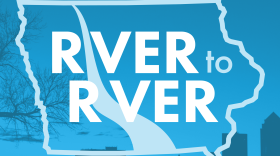Driverless vehicles are in America's future, but how can they be made safe? A team of researchers at the University of Iowa are helping find the answer to that question and ensuring that once automated vehicles are ready for everyday public use, rural roads aren't left out of the picture.
That's why the UI's Driving Safety Research Institute tests its automated vehicle on gravel — one of the few research institutions to do so.
It's part of a project called Automated Driving Systems (ADS) for Rural America, which is testing the use of automated driving technologies on rural roadways to examine and understand the unique needs of rural environments while working toward solutions that improve safety and mobility. The program hopes to one day use the vehicles to transport rural Iowans to services they need, like healthcare facilities, grocery stores and more.

The test vehicle looks like an airport shuttle bus. It has eight seats and is equipped with a wheelchair lift to make it accessible.
"When we first envisioned this program ... we wanted to provide a vehicle that could give rural Americans access," said UI engineering professor Dan McGehee, director of the Driving Safety Research Institute.
Rural roads can present unique challenges, like sharp curves, limited sight distances, no lane markings and extreme weather conditions. McGehee noted that many of the self-driving vehicles that exist already are tested mainly in tech-savvy areas, like Silicon Valley, where the weather is generally warmer and more predictable and the roads are clearly marked.
"Many have not driven on a gravel road," he said. "There are no sensors in the road, there's no paint for computer vision for systems to see. This is very unique."
The test vehicle operates by using liDAR — laser scanning that paints a "picture" of the space around the car to detect road markings, obstacles and signage. The vehicle is not entirely self-driving yet — two safety drivers sit in the front, monitoring the automation and taking the wheel as needed to navigate the car through things like road construction — but the car can otherwise drive, accelerate, stop and turn on its own.
Not only is the car monitored — its passengers are, too. While riding, passengers are given a wristband to monitor their anxiety levels and given a survey to gather their feelings about the drive as part of the research. Many passengers report low to moderate anxiety levels, which McGehee suggested is somewhat alleviated due to the presence of the safety drivers.
"Safety is of paramount importance while we drive," he said.

Once the car reaches its gravel route, the steering wheel glows blue and it begins to move forward at a steady — and safe — 25 miles per hour. The safety driver's hands hover over the steering wheel, but the car rumbles down the road safely.
The demonstration is impressive, but McGehee says it will still be some time before automated vehicles are ready for mass use, or even for transporting rural Iowans. He suspects that once vehicles do start to make their way onto public roads, the first will be shuttle-like self-driving buses that move at a slower speed from parking lots to events.
"It's something we feel is still pretty far away," he said.
Still, his team is excited about the possibilities.
"I think what's really important about our research at large is that we really want Iowans to get access to safety systems," McGehee said. "Getting Iowans the ability to drive in this vehicle is exciting... we're very excited to take this to rural Iowa first and demonstrate this technology."





